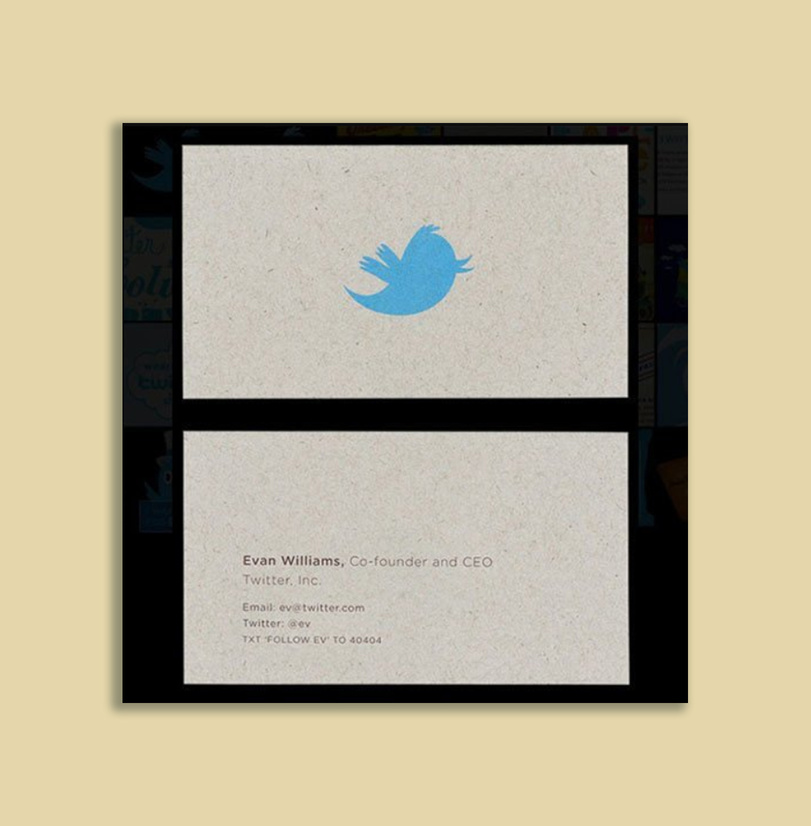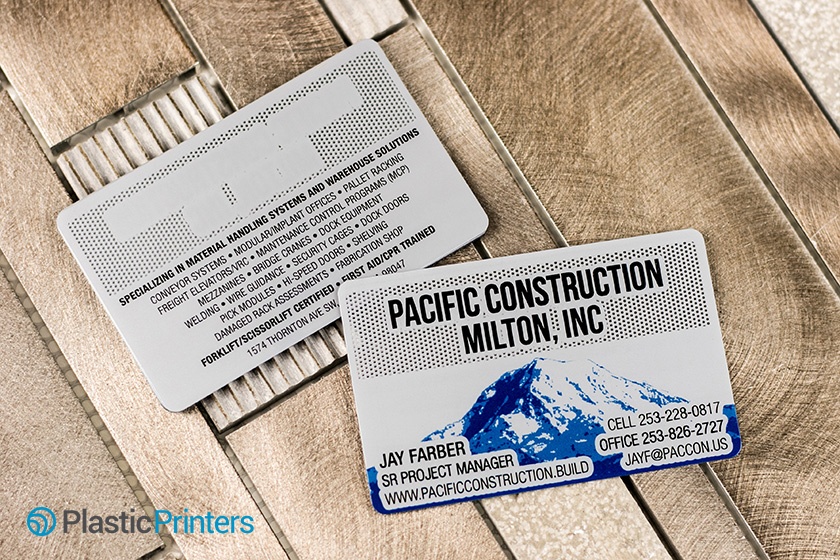- Plastic Business Cards
- Gift Cards
- Key Tags
- Custom Products
- Custom Plastic Cards
- Resources

Before you start thinking about card materials or sizes, you need to be thinking about your brand. When handing out a visual item like a card, aesthetics and consistency are important. The colors that compliment your brand will likely be the first thing your client notices, so complimentary color schemes that are consistent with your logo or the font your brand uses will be important. The more unified your card looks, the easier it will be to remember your card and attain its information. Let’s look at an example.
Evan Williams’ card is even consistent with the card’s material. The font color compliments the recycled look of the card, and the font style is consistent with the Twitter brand. The logo, then, is front and center, providing all the color to the card. It’s immediately recognizable and memorable, aand it’s because every aspect of the card matches and compliments the other aspects of the card. Keeping your card consistent with your brand helps the card feel cohesive and representative of your work.


A business card can easily be an extension of your business, and it’s up to your design to reflect it. You can utilize material and type to create a memorable card that shows off your business without the need for words. If you work with metal, pick a metal card. If you’re a photographer, utilize transparent material to make a card that looks like a camera lense. If you’re a graphic designer, use an NFC card to send clients directly to an online example of your work. In terms of how to construct a business card, the options are basically limitless; if you can broadcast your business with a special design, your card will easily stand out from the rest.
You will definitely come across card sizes while designing your card. One reason is because the standard business card size, 3.5“ x 2”, is too large to fit into an average wallet. Size will control whether or not your card stays in the pocket of your client, so you have to determine how to apply your business design to your card’s chosen size, and there are many to choose from. While 3.5“ x 2” is the most common card size, our recommended size is the standard credit card size, 3.375“ x 2.125”, which easily fits into your clients’ wallets. That’s not all; you can choose a square or circular card, a mini card, or if you want to create a custom shape and design, each choice will change your card shape and how long they stay in a pocket.
Your card’s material will leave one of the larger impressions on your client. Paper is traditionally professional and classy, while plastic is the most versatile material leading to the most customization, and stands out with its look and durability. There are plenty of other less traditional, specialized materials that can be used to various effects, like metal, recycled material, cork, or wood. Each will stand out in a different way, with the major downside being cost. Your card should represent your business and your work, and if a special material will help you emphasise those aspects, the choice is yours!
Your card’s corners can seem like a small detail, but can impact your card’ impression in surprising ways. Rounded corners can make your card seem more friendly and appealing, while square corners can make your card seem more professional. Corner choice will also change your card’s size and portability. Rounded corners improve the durability of your card when it’s being stored in a wallet or a pocket, while sharp, traditional corners can lead to tears and rips in transit or storage. Though the choice may seem small, it can have far-reaching benefits and costs.
Choosing a finish can help elevate your message. Depending on what impression you’re trying to leave, there is a type of finish for you. Foiling or foil stamping is a premium printing method that involves the creation of a custom metal die of your artwork. Uncoated business cards have a natural look that puts the focus on your logo and contact info. Add shine to your design and make a powerful first impression and statement with a glossy finish. There are many more to choose from, and each can help in a different way.
While designing your card, you might be asked about your color options, which look like this: 4/0, 4/1, 4/4. This may look complicated at first glance, but are actually rather simple. 4/0 means only one side of the card is full color, and the other side will be fully blank. 4/1 means one side is full color, while the other side won’t have full color, but may have text on it. 4/4, then, means full color on both sides. Beyond the color placement on your card, it should maintain a consistency with both the material and your brand. Using your card and your brand together can produce an eye-catching card without any extra work!
Your card’s design doesn’t need to be as standard as picking rounded or traditional corners; your card’s design is limited only by your creativity. There are plenty of different styles you can choose for your card to make it stand out from the heaps of other cards. This can be anything from utilizing a transparent card design to emphasize your text to designing a business card meant to be written on, there are plenty of extra customization choices. Examples include stickers, tearaway cards, mini cards, foldable cards, magnets, embossed, and custom shapes.
Card thickness impacts how your card feels. Thicker cards have a bit more weight to them, and usually feel sturdier and less flimsy than less thick cards, giving them a premium feel. A thicker card can help you stand out from the competition; how thick your business card is largely depends on what material its printed on. Paper business cards are thinner than plastic business cards; 14pt and 16pt are the most common business card stocks, and the thickness of those cards are about as thick as a flyer or postcard. 32pt stock would be considered an extra thick business card. Plastic business cards are usually thicker than paper business cards, and typically round out around 30 mil, or .03 inches in thickness.
Once your card’s look has been solidified, now you need to decide what it should say. This is the information about you that potential clients or employers will keep after you’ve left, so you have to be selective about information they should keep. Here are some recommended choices.
What content and information your card can present has been forever changed. Equipped with near-field communication (NFC), your business card can now deliver your contact information, social networks, video, websites, and so much more, straight to any smartphone. You can easily customize and update the information you send to your clients and prospects. You can customize and update the card’s content; they’re incredibly easy to share, they’re great for contact management, and they stand out from the crowd. If you want your card to open your businesses website, or open a schedule to create a meeting, NFC make your networking a whole lot smoother.
Your card can also have a QR code printed on it, allowing you to share your contact details, business information, work samples and much more with just one scan. Using the vCard Plus QR Code on your business card means potential clients or employers can add your contact information to their mobile devices without the hassle of manually typing it in. All they need to do is scan and save. In the same vein, adding a Social Media QR Code that links to your social media platforms will not only garner more followers and fans on your pages, but will also allow your clients to remain up to date on all your latest work, news, and events.